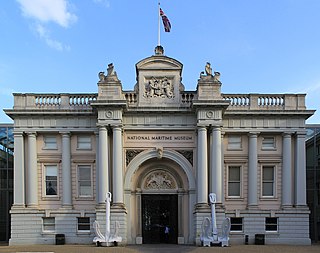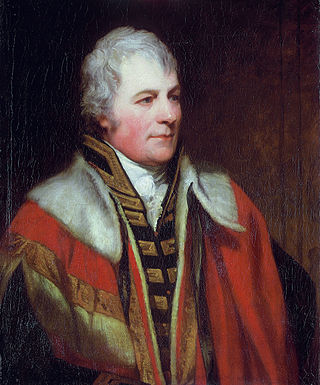Related Research Articles

The Battle of Trafalgar was a naval engagement that took place on 21 October 1805 between the British Royal Navy and the combined fleets of the French and Spanish Navies during the War of the Third Coalition of the Napoleonic Wars (1803–1815).

The National Maritime Museum (NMM) is a maritime museum in Greenwich, London. It is part of Royal Museums Greenwich, a network of museums in the Maritime Greenwich World Heritage Site. Like other publicly funded national museums in the United Kingdom, it has no general admission charge; there are admission charges for most side-gallery temporary exhibitions, usually supplemented by many loaned works from other museums.

Earl Nelson, of Trafalgar and of Merton in the County of Surrey, is a title in the Peerage of the United Kingdom. It was created on 20 November 1805 for the Rev. William Nelson, 2nd Baron Nelson, one month after the death of his younger brother Vice-Admiral Horatio Nelson, 1st Viscount Nelson, the famous naval hero of the Napoleonic Wars and victor of the Battle of Trafalgar of 21 October 1805. The title is extant, the present holder being Simon Nelson, 10th Earl Nelson, who has an heir apparent. The family seat of Trafalgar House in Wiltshire was sold in 1948 by Edward Nelson, 5th Earl Nelson.

Sir John Orde, 1st Baronet was a British Royal Navy officer. The third son of John Orde, of Morpeth, Northumberland, and the brother of Thomas Orde-Powlett, 1st Baron Bolton, he is remembered as a professional enemy of Nelson. Orde's quarrel was actually more with Lord St Vincent and he never attacked Nelson personally.

"England expects that every man will do his duty" was a signal sent by Vice-Admiral of the Royal Navy Horatio Nelson, 1st Viscount Nelson from his flagship HMS Victory as the Battle of Trafalgar was about to commence on 21 October 1805.

HMS Agamemnon was a 64-gun third-rate ship of the line of the British Royal Navy. She saw service in the American Revolutionary War, French Revolutionary, and Napoleonic Wars and fought in many major naval battles. She is remembered as Horatio Nelson's favourite ship, and she was named after the mythical ancient Greek king Agamemnon, the first ship of the Royal Navy to bear the name.

HMS Neptune was a 98-gun second-rate ship of the line of the Royal Navy. She served on a number of stations during the French Revolutionary and Napoleonic Wars and was present at the Battle of Trafalgar in 1805.

In the Battle of Cape Finisterre off Galicia, Spain, the British fleet under Admiral Robert Calder fought an indecisive naval battle against the combined Franco-Spanish fleet which was returning from the West Indies. In the ensuing battle the British captured two Spanish ships of the line, but failed to prevent the joining of French Admiral Pierre de Villeneuve's fleet to the squadron of Ferrol and to strike the shattering blow that would have freed Great Britain from the danger of an invasion. Calder was later court-martialled and severely reprimanded for his failure and for avoiding the renewal of the engagement on 23 and 24 July. At the same time, in the aftermath Villeneuve elected not to continue on to Brest, where his fleet could have joined with other French ships to clear the English Channel for an invasion of Great Britain.

Admiral Sir Robert Calder, 1st Baronet, was a British naval officer who served in the Seven Years' War, the American Revolutionary War, the French Revolutionary Wars and the Napoleonic Wars. For much of his career he was regarded as a dependable officer, and spent several years as Captain of the Fleet under Admiral Sir John Jervis. However, he is chiefly remembered for his controversial actions following the Battle of Cape Finisterre in 1805 which resulted in his court-martial. Though he was removed from his sea command, he was retained in the Navy and later served as Commander-in-Chief of the base at Plymouth.

Admiral William Carnegie, 7th Earl of Northesk was a British naval officer who served during the American Revolutionary War, French Revolutionary War, and Napoleonic Wars. While in command of HMS Monmouth he was caught in the Nore Mutiny of 1797 and was the officer selected to relay the demands of the mutineers to George III. He most notably served as third-in-command of the Mediterranean Fleet at the Battle of Trafalgar in HMS Britannia. He later became Rear-Admiral of the United Kingdom and Commander-in-Chief, Plymouth.

Admiral Sir William Cornwallis, was a Royal Navy officer. He was the brother of Charles Cornwallis, 1st Marquess Cornwallis, British commander at the siege of Yorktown. Cornwallis took part in a number of decisive battles including the siege of Louisbourg in 1758, when he was 14, and the Battle of the Saintes but is best known as a friend of Lord Nelson and as the commander-in-chief of the Channel Fleet during the Napoleonic Wars. He is depicted in the Horatio Hornblower novel, Hornblower and the Hotspur.
The National Museum of the Royal Navy, Portsmouth, formerly known as the Royal Naval Museum, is a museum of the history of the Royal Navy located in the Portsmouth Historic Dockyard section of HMNB Portsmouth, Portsmouth, Hampshire, England. The museum is part of the National Museum of the Royal Navy, a non-departmental public body sponsored by the Ministry of Defence. It received 1,081,909 visitors in 2017.

The Battle of Cape Ortegal was the final action of the Trafalgar campaign, and was fought between a squadron of the Royal Navy and a remnant of the fleet that had been defeated earlier at the Battle of Trafalgar. It took place on 4 November 1805 off Cape Ortegal, in north-west Spain and saw Captain Sir Richard Strachan defeat and capture a French squadron under Rear-Admiral Pierre Dumanoir le Pelley. It is sometimes referred to as Strachan's Action.

SS Cap Trafalgar was a German ocean liner launched in 1913 for the Hamburg Süd line. In 1914, she was converted for use as an auxiliary cruiser during World War I. She was the first armed merchant cruiser sunk by a ship of the same class; she was destroyed by HMS Carmania, also a converted ocean liner, in a furious action in the South Atlantic on 14 September 1914. It was the world's first battle between former ocean liners.
Colin Saunders White was a British military historian, director of the Royal Naval Museum from 2006 until his death and one of Britain's leading experts on Admiral Horatio Nelson and the Battle of Trafalgar.
Admiral Sir Thomas Bladen Capel was an officer in the British Royal Navy whose distinguished service in the French Revolutionary War, the Napoleonic Wars and the War of 1812 earned him rapid promotion and great acclaim both in and out of the Navy. He was also a great friend of Admiral Nelson and can be considered a full member of Nelson's "band of brothers".

HMS Victory is a 104-gun first-rate ship of the line of the Royal Navy. She was ordered in 1758, laid down in 1759, and launched in 1765. With 246 years of service as of 2024, she is the world's oldest naval vessel still in commission.

Antonio de Escaño y García de Cáceres was a Spanish military officer and government official. He served in several naval battles including the Battle of Trafalgar. He was Spain's Minister of the Navy and a member of the Council of Regency. A Spanish Navy school named for him states: "He is regarded as one of the best naval tacticians of the 18th century. An enlightened man, he devoted himself to the study of shipbuilding and other academic disciplines such as chemistry, botany and history, of which he was an academic."

This Bibliography covers sources for Royal Navy history through the 18th and 19th centuries. Some sources may be duplicated in sections when appropriate. Among the contemporary and earlier historical accounts are primary sources, historical accounts, often derived from letters, dispatches, government and military records, captain's logs and diaries, etc., by people involved in or closely associated to the historical episode in question. Primary source material is either written by these people or often collected, compiled, and/or written and published by other editors also, sometimes many years after the historical subject has passed. Primary sources listed in this bibliography are denoted with an uppercase bold ' (P) before the book title. Publications that are in the public domain and available online for viewing in their entirety are denoted with E'Book.
The San Fernando Naval Museum is a naval museum located in San Fernando in the Province of Cádiz, Andalusia, Spain. Although a naval museum was called for as early as 28 September 1792. A museum was established in 1843, but the current museum was inaugurated on 27 March 1992, with the main purpose to promote the history of the presence of the Spanish Armada in the area.
References
- ↑ "Ships of the Royal Navy at Trafalgar". Archived from the original on 14 February 2012. Retrieved 29 March 2012.
- ↑ Findling, John E; Pelle, Kimberley D, eds. (31 January 2024). "Appendix D:Fairs Not Included". Encyclopedia of World's Fairs and Expositions. McFarland & Company, Inc. p. 426. ISBN 9780786434169.
- 1 2 3 "1905 NAVAL" . Retrieved 29 March 2012.
- ↑ "NMA Collection Search Letter of thanks from London Exhibitions Ltd, 1905" . Retrieved 31 March 2012.
- ↑ "Valance - Victoria & Albert Museum - Search the Collections" . Retrieved 29 March 2012.
- ↑ "NMA Collections Search Exhibition loan receipt for Captain Cook's Chart Rule, 1905" . Retrieved 30 March 2012.
- ↑ "Captain James Cook (1728-1779)". christies.com. Christie's. Retrieved 30 March 2012.
- ↑ "NMA - Collections search results" . Retrieved 5 April 2012.
- ↑ "The Ships - Manx Transport Heritage Museum - The Island's Smallest Museum" . Retrieved 29 March 2012.[ permanent dead link ]
- ↑ "The Flying Machine, Earl's Court from Prints-online: Beautiful posters, prints and merchandise with a historical theme" . Retrieved 30 March 2012.